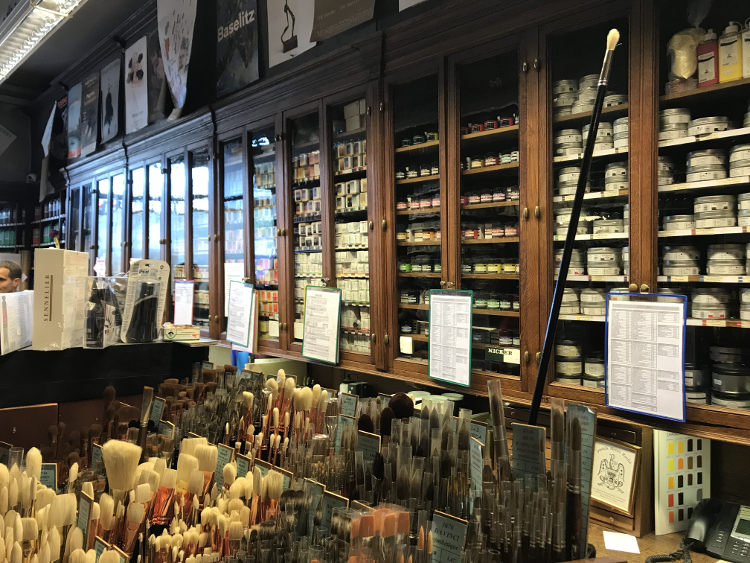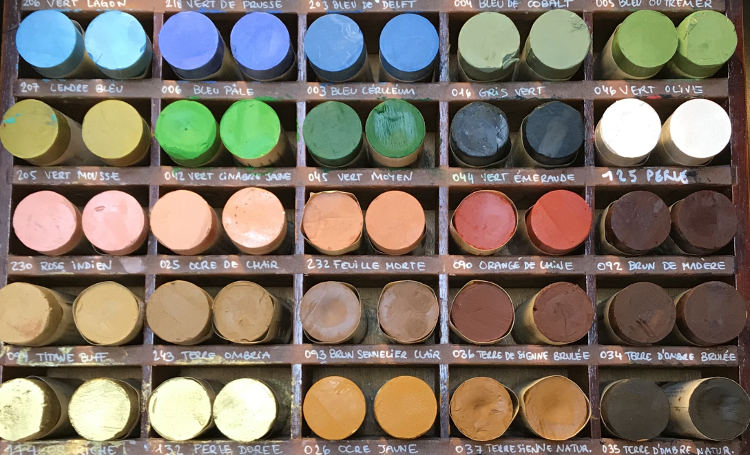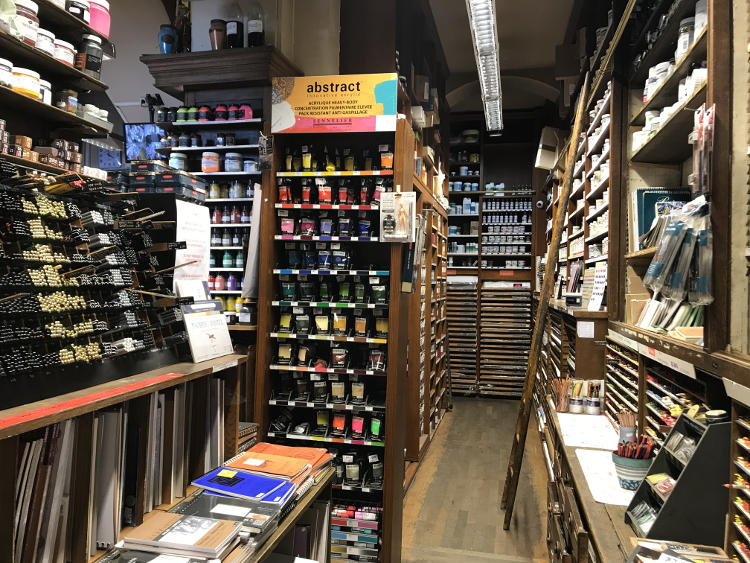
Sennelier – Art and Invention in One of the Oldest Art Supply Stores in Europe
Have you ever stood in front of a masterpiece and wondered about the origin of its parts—the canvas, the stretcher bars, or the paint? The Sennelier art store in Paris has been selling high quality, hand made painting supplies to some the most distinguished artists in the world for more than four generations. Who shops there? “We prefer not to give names, to protect their privacy,” says sales manager Juliette Tiberghien, but in many cases the secret is already out: Paul Cézanne, Edgar Degas, Paul Gauguin, Amedeo Modigliani, Wassily Kandinsky, and Pierre Bonnard all bought supplies at Sennelier. (The stamp of the store can be found on the back of some of their canvases.) More recently, David Hockney bought supplies there with which to create his 60-canvas masterpiece “Grand Canyon” (1998). However, perhaps the most famous Sennelier paint story concerns the inventor of Cubism himself—Pablo Picasso—and a unique medium known as the oil pastel. Like crayons for masters, oil pastels are as lightweight and portable as lipstick. They can be used to paint on almost any surface, with colors as vibrant, and textures as varied, as those in great oil paintings. The original idea behind the medium was to infuse pigments into an easy to use, portable drawing implement that would produce no dust—a goal first accomplished in 1924 by the Sakura Color Products Corporation of Japan, with a product known as “Cray-pas” (a mash-up of the words crayon and pastel). Though intended for children to use, the company also marketed “Cray-pas” to avant-garde artists—among them, Picasso, who used them at least as early as the 1930s. After the defeat of Japan in World War II, however, “Cray-pas” were impossible to get, so one day Picasso entered the Sennelier paint shop and asked for an alternative. Henri Sennelier, the third generation of the family to run the store, took on the challenge. After a year of work, he created a unique oil pastel product far superior to anything that had come before it. If you see a Picasso oil pastel drawing made after 1948, rest assured it was made with a Sennelier product—a product which to this day is still considered the industry gold standard.
A Colorful Vision
The story of the Sennelier art supply company begins in 1887, on the picturesque Paris street of Quai Voltaire. Located along the Seine and named for the 18th-century French writer known for satirically challenging the institutions of his day, the street has long attracted bohemians, writers, artists, and students. One day in 1887, while still a chemistry student at the National Conservatory of Arts and Crafts, the young Gustave Sennelier happened to pass by an art supply store for rent at 3 Quai Voltaire, just a block away from the École nationale supérieure des Beaux-Arts, one of the most important art schools in the world. Inspired by a love of chemistry and color, and certain the location was being underutilized, Sennelier snapped up the lease and transformed one of the rooms into a workspace. Sourcing pigments from around the world, he began manufacturing his own paints, often creating products to order for the artists who patronized his store.

Sennelier art store in Paris. Photo courtesy IdeelArt.
It would be many more decades before Frank Stella, in 1964, would declare that his paintings were “based on the fact that only what can be seen there is there,” coining the famous phrase, “What you see is what you see.” Rebuking the tendency of viewers to perceive meaning and story in paintings, when all that is truly there is paint, Stella also frequently bemoaned the fact that the material quality of finished paintings are never really as perfect as the paint in the can. Sennelier was far ahead of Stella in his reverence for the medium. In 1912, he even published a book that revealed all of his techniques, sharing his scientific secrets out of the simple, sincere belief that the paint is the most significant part of a painting. Though there were more than 600 other art supply stores in Paris at the time Sennelier was founded, the passion Sennelier had for his craft set him apart and allowed him to transform a formerly bankrupt art supply store into one of the oldest, most respected art supply stores in the world.

Sennelier art store in Paris. Photo courtesy IdeelArt.
Material Relationships
Passion for the craft behind art has not waned in the Sennelier family over the generations. In fact, for artists who dream of creating their own signature hue, such as Yves Klein did in 1960 with International Klein Blue, Sennelier is the perfect place to start. Along with only a couple of other paint shops—such as L. Cornelissen & Son in London, and Zecchi in Florence—Sennelier in one of the few remaining stores in existence that still sells dry pigments, allowing contemporary artists what has become a rare privilege: the chance to hand craft their own mediums from the original source materials.

Sennelier art store in Paris. Photo courtesy IdeelArt.
In addition to offering artists the chance to make a unique medium to use in their studios, the store also stocks a selection of rare papers and other nearly impossible to find items. As anyone who has walked the packed aisles of the store will tell you, many of these secret treasures can only be discovered by shoppers in person, usually when they have come in looking for something else. It is that sense of a personal connection to their art materials that sales manager Tiberghien believes makes the store as relevant to artists now as ever. “Here the atmosphere is really special,” she says. “People like the human contact so, yes, they keep coming to have advice.” In this age of chain stores and instant home delivery, at least we know that the sense of mystery and humanity so integral to the creation of art is still alive in Paris, in this little shop by the Seine.
Featured image: Sennelier art store in Paris. Photo courtesy IdeelArt.
By Phillip Barcio






